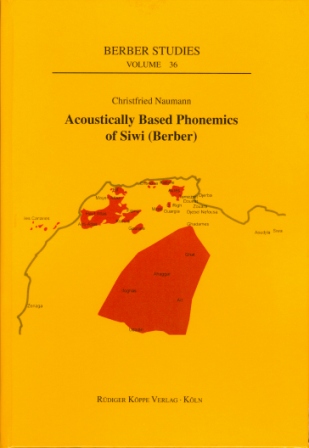
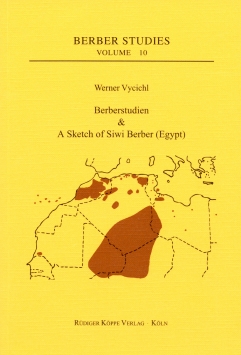
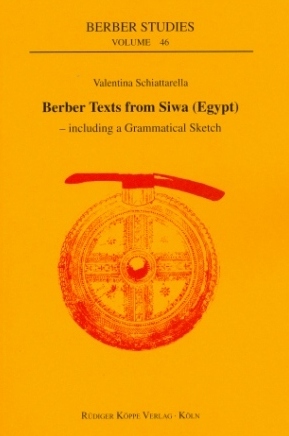
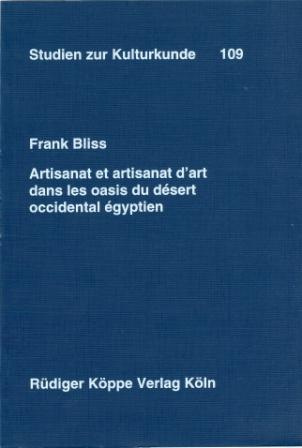
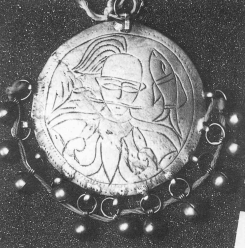
Acoustically Based Phonemics of Siwi (Berber)
Author: Christfried Naumann. Series edited by: Harry Stroomer.
Series: BS Berber Studies Volume 36
201222 pp. Roman, 436 pp.
3 maps, 180 spectrograms, 50 waveforms, 324 diagrams, numerous tables and charts, appendix
Text language(s): English
E-book
€ 69.80
Buy 'Acoustically Based Phonemics of Siwi (Berber)' as a downloadable PDF document directly from our online shop »
This dissertation investigates the inventory of segmental speech sounds and their acoustic characteristics for the Siwi language, which is the most easterly variety of Berber spoken by approximately 15,000 people in the oases of Siwa and Qara in the northwestern part of Egypt. The status of Siwi as a spoken language is rather strong in Siwa and Qara as compared to the situation of some other Berber varieties. Siwi is not an undescribed language, but most of the relevant existing literature can be subsumed as word lists, grammar sketches, or articles dedicated to specific topics.
The purpose of this dissertation is to investigate the inventory of segmental speech sounds (phonemes) of Siwi by characterising their distinct acoustic properties. This approach is assumed to improve the validity of phonemics within descriptive linguistics (‘basic linguistic theory’), which conventionally relies on impressionistic, non-falsifiable phonetic transcriptions. The conclusions of this study are drawn from the acoustic investigation of elicited words and phrases recorded with five speakers, based on preceding linguistic fieldwork and the manuscript of the sketch grammar by Vycichl 2005 (see link at the bottom).
The structure of this thesis is as follows: chapter 2 gives an outline of the basic theoretical assumptions, concepts and premises. Chapter 3 provides a brief introduction to acoustic techniques in order to facilitate the access to the evidence and illustrations of the later chapters for readers less familiar with phonetic data. Chapter 4 describes gross acoustic features by which the major sound classes, such as vowels, stops and fricatives, can be distinguished independent from context.
Chapters 5 through 7, in turn, investigate more fine-grained and context-sensitive distinctions (related to place of articulation) and the resulting sound categories within the major sound classes. The feature system is continued, with slight modifications, for the examination of the remaining classes of consonants in chapter 6, while chapter 7 discusses vowels. Chapter 8 summarises the inventory of distinctive (segmental) speech sounds of Siwi, proposes an orthographic representation, and briefly addresses phonological topics not covered by the main chapters or requiring further research.
This book is the fully revised version of the author’s PhD dissertation that was accepted under the same title the Faculty of History, Arts and Oriental Studies at the Universität Leipzig/Germany, following the defense on June 24th, 2011.
In the same series a grammatical sketch and a study of language contact between Siwi and Arabic have been published, as well as a text collection of Siwi Berber. Furthermore, an ethnographic account of craftsmanship and architecture in Siwa is available:
Accompanying material:
- Berber and Arabic in Siwa (Egypt)
(ISBN 978-3-89645-937-4 ) - Berber Texts from Siwa (Egypt)
(ISBN 978-3-89645-979-4 ) - Berberstudien & A Sketch of Siwi Berber (Egypt)
(ISBN 978-3-89645-389-1 ) - Essai sur la phonologie du proto-berbère
(ISBN 978-3-89645-035-7 )
Cross-reference:
- A Trilingual !Xóõ Dictionary — !Xóõ – English – Setswana
(ISBN 978-3-89645-881-0 ) - Advances in Minority Language Research in Nigeria vol. I
(ISBN 978-3-89645-426-3 ) - African Linguistics at the Crossroads
(ISBN 978-3-89645-120-0 ) - Arabs and Arabic in the Lake Chad Region
(ISBN 978-3-927620-23-0 ) - Artisanat et artisanat d’art dans les oasis du désert occidental égyptien
(ISBN 978-3-89645-204-7 ) - L’océan des pleurs
(ISBN 978-3-89645-998-5 ) - Le tetserret, langue berbère du Niger
(ISBN 978-3-89645-938-1 ) - Siirat Sayf ibn Dhi Yazan – An Arabic Folk Epic
(ISBN 978-3-89645-506-2 ) - The Berber Literary Tradition of the Sous
(ISBN 978-3-89645-999-2 )
| « back | Print version | [top] |
 Books
Books Audio
Audio Biographies
Biographies Series
Series Festschrifts
Festschrifts Journals
Journals